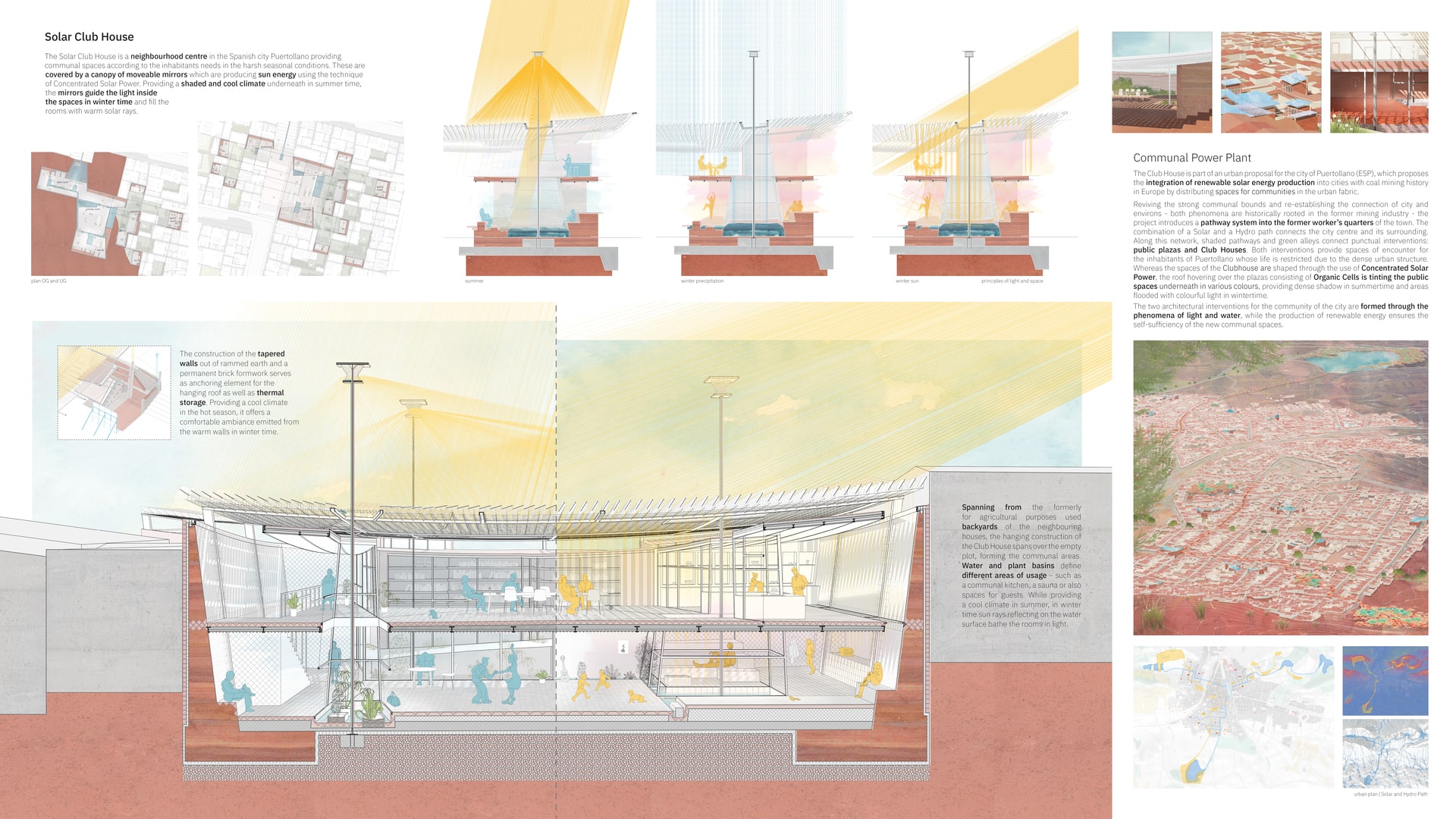Project Description
How can the phenomena of solar light shape communal spaces according to seasonal requirements in cities while ensuring a self-sufficient energy supply? The project proposes the implementation of neighbourhood centres in the city fabric of Puertollano, Spain. Whilst providing spaces for communal activity the so-called Solar Club House produces solar energy which ensures its self-sufficiency. Shaped by the phenomena of water and light, the new spaces of encounter offer rooms for activities according to the inhabitants needs in the harsh seasonal conditions. Expanded Context Due to Europe ‘s agreement to be carbon neutral in 2050, the EU is in the middle of a major energy transition. The proportion of renewable energy is and will be critical for the EUs infrastructural supply, whereas solar energy is one of the major potential sources of sustainable energy production in Europe. However, compared to former energy sources (fossil fuels), the harvest of solar energy is an extremely space demanding method. Though, space is a rare good in Europe, which makes the necessity to implement the production of renewable energy – and especially of solar energy – into our cities omnipresent. The question arises, how the consequential juxtaposition of urban social networks and energy infrastructure can create surplus value for our living environments. How can - next to enabling self-sufficient energy supplies - the phenomena of light therefore shape our spaces of encounter? Urban Proposal The project Communal Power Plant proposes the integration of solar energy production into the urban fabric of Puertollano (ESP) while producing spaces for communities. Set in a city of former coal mining, the project derives from strong bonds of communities which are historically rooted in the coal industry. Next to an infrastructural transition concerning their labor landscape and energy supply, also the social fabric in former coal cities are facing a major shift. Along a proposed network of solar and hydro paths, which reconnect the city centre with Puertollano’s former working quarters, new neighbourhood centres are established: The Solar Club Houses. The Solar Club House The seek for shade due to the intense solar radiation and heat in summertime and the strive for warm solar light in wintertime shapes the life of the inhabitants living in the restrictive dense city fabric of Puertollano. Originating from informal housing built by coal workers in the 20th century, the small houses lack space and also public areas are underrepresented in the monofunctional and derelict former worker’s quarters. In order to provide room for communal activity adapted to the intense sun and weather conditions in the geographical centre of Spain, the Solar Club House offers seasonally adapted spaces which are providing a pleasant climate in summertime while being sunlit in wintertime. Architectural Implementation The Solar Club House is covered by a canopy of moveable mirrors which are producing sun energy using the technique of Concentrated Solar Power. In summertime, the intense solar radiation is guided to the so-called receiver points, producing energy while enabling a cool climate in the shaded areas underneath. In contrast, in wintertime the light is guided inside the spaces and fills the rooms with warm solar rays. In this way, the Solar Club House offers space for various activities according to the weather: Be it tango dancing in summertime in the cool climate of the communal activity room or relaxing and warming up in wintertime in the sun-drenched collective sauna. Tectonics The construction of tapered walls out of rammed earth and a permanent brick formwork serves as anchoring element for the hanging roof as well as thermal storage. Nesting on basement level in between the existing houses, the walls emit the cold stored in the surrounding ground in summertime. In wintertime, the communal spaces offer a comfortable ambiance due to the warm walls storing solar thermal energy. Spanning from the formerly for agricultural purposes used backyards of the neighbouring houses, the hanging construction spreads over the empty plot, forming the communal areas. Water and Light The production of renewable energy can then be considered efficient, once two types of new sources are combined. Therefore, the urban masterplan proposes the combination of a solar power plant with and urban pump storage syste. Also, the architectural implementation is defined by water and light. The spaces of the Solar Club House are shaped according to seasonal solar conditions. Additionally, water and plant basins define areas of different usage. In this way, spaces for communal activities as well as private entities for guests are provided, whereas the sunrays reflecting in the water basins bathe the rooms in light. The interaction of the phenomena of light and water shape the spaces of the Solar Club House. While providing rooms of encounter for the inhabitants of the city and their guests, the production of solar energy ensures the self-sufficiency of the new communal spaces of Puertollano.
